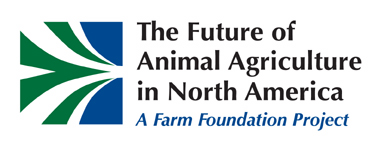Projects
Future of Animal Agriculture in North America
|
|
North America enjoys highly efficient livestock production systems that have adapted and evolved to m eet changing conditions. The industry is competitive in the world market, but faces significant opportunities and challenges both in North America and abroad, according to an 18-month study released April 18, 2006, by Farm Foundation. eet changing conditions. The industry is competitive in the world market, but faces significant opportunities and challenges both in North America and abroad, according to an 18-month study released April 18, 2006, by Farm Foundation.
The study is believed to be the first to take a comprehensive look at the opportunities and challenges facing the major species of the animal agriculture industry in Canada, Mexico and the United States. The project involved more than 150 individuals from the three countries, representing producers, industry, government agencies and academia. “Farm Foundation undertook this study to engage individuals and organizations in discussion of the challenges and opportunities facing animal agriculture, and in so doing, to provide public- and private-sector leaders with comprehensive and objective information to use in their decision making,” says Farm Foundation President Walter Armbruster. “This study does not make policy recommendations. The report highlights commonalties, differences and areas where future work may be needed.” “This is a critical time for animal agriculture in North America,” adds former Congressman Charlie Stenholm who co-chaired the Project Steering Committee with Armbruster. “If I was still on the House Agriculture Committee, I would welcome a study of this type—it is very comprehensive. It outlines the challenges and identifies some of the choices that need to be made.” Study participants examined the industry’s challenges and opportunities in seven basic areas: economics of production, processing and marketing; consumer demands; global competitiveness and trade; food safety and animal health; environmental issues; community and labor; and animal welfare. Cross-cutting themes, strategies and policy issues which emerged include:
Farm Foundation works as a catalyst focused on economic and policy issues facing agriculture, the food system and rural communities. Unlike many nonprofits and nongovernmental organizations, Farm Foundation does not advocate, lobby or press a point of view. The full report, including an executive summary are posted here. Project Structure The project was directed by a Steering Committee organized by Farm Foundation and representative of the broad spectrum of those interested in and concerned about animal agriculture. The project was organized around seven Working Groups:
Each Working Group was comprised of individuals representing a broad spectrum of interests in the animal agriculture industry, government and community/non-agricultural interest groups. An academic chair served as the lead writer/researcher of each Working Group. The full report was available in English, Spanish and French. Executive Summary: The Future of Animal Agriculture in North America
|
